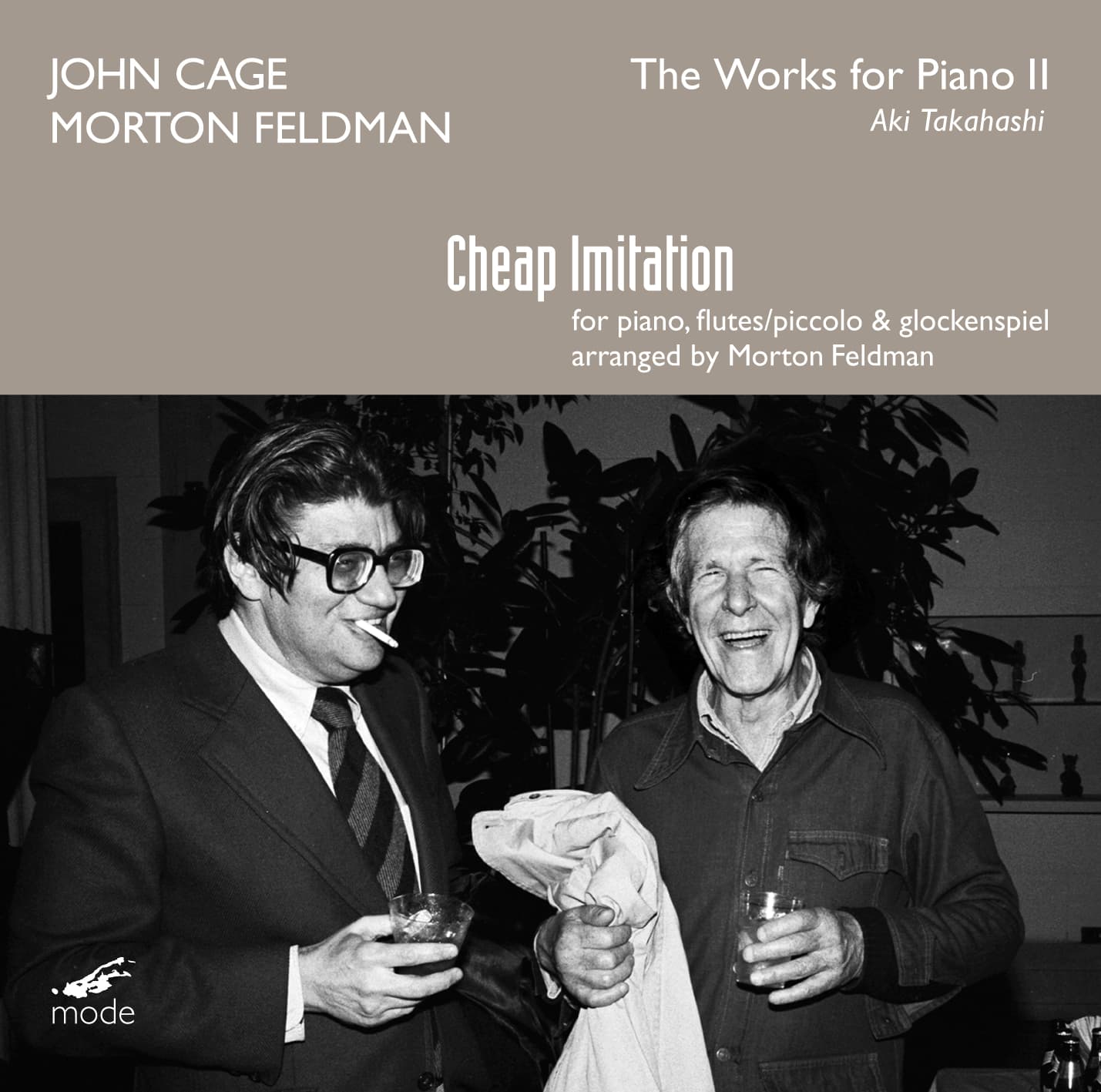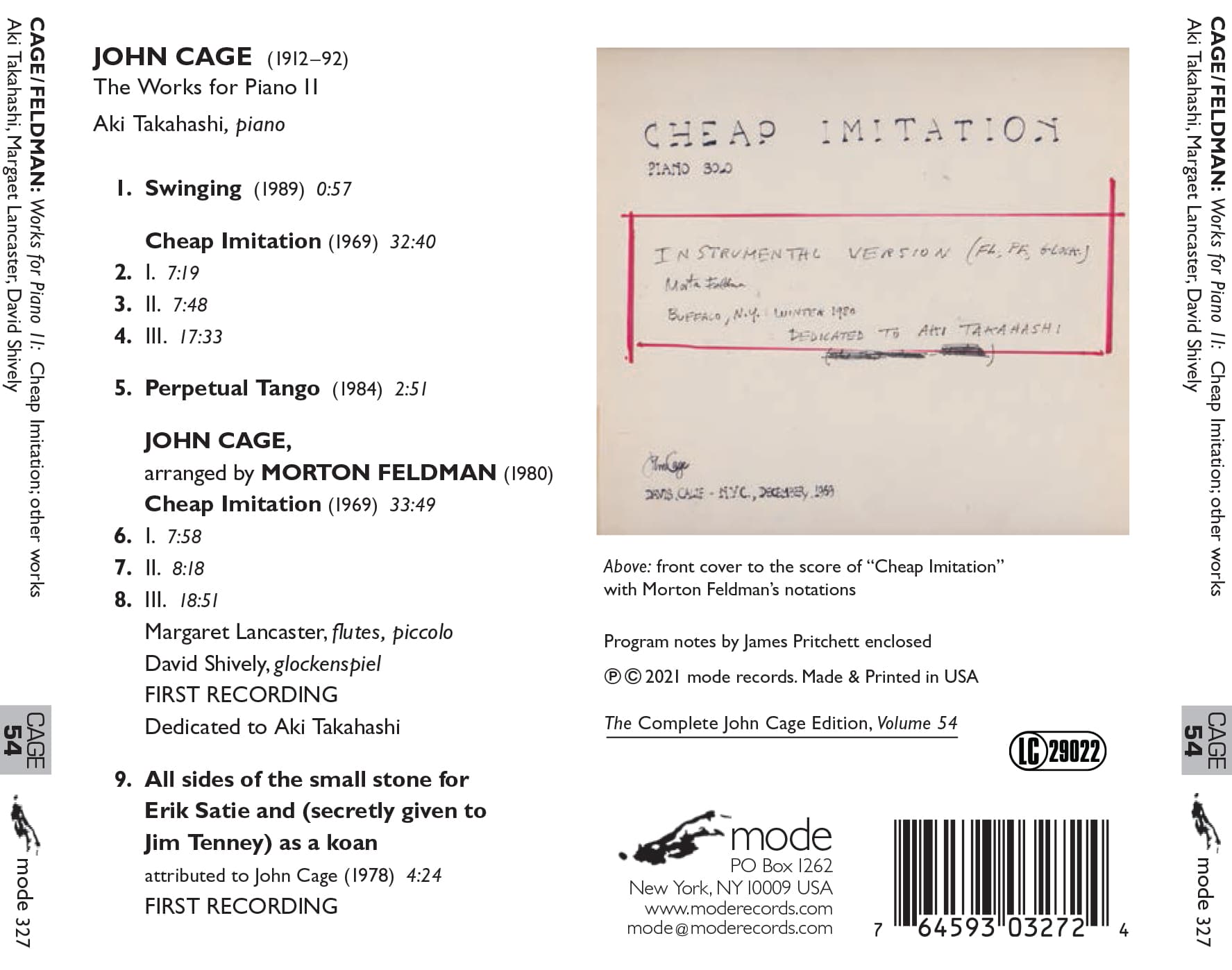1. Swinging (1989) 0:57
Cheap Imitation (1969) 32:40
2. I. 7:19
3. II. 7:48
4. III. 17:33
5. Perpetual Tango (1984) 2:51
JOHN CAGE, arranged for trio by MORTON FELDMAN (1980)
Cheap Imitation (1969) 33:49
6. I. 7:58
7. II. 8:18
8. III. 18:51
Margaret Lancaster, flutes, piccolo
David Shively, glockenspiel
FIRST RECORDING
Dedicated to Aki Takahashi
9. All sides of the small stone for Erik Satie and (secretly given to Jim Tenney) as a koan
attributed to John Cage (1978) 4:24
FIRST RECORDING
CAGE – SATIE – FELDMAN – TAKAHASHI sums up the focus of this album. All of these works by Cage are influenced by Satie. Cage’s friend and colleague Morton Feldman made an arrangement of Cage’s solo piano “Cheap Imitation” for a trio of piano, flutes/piccolo and glockenspiel. Feldman’s admiration for the pianist Aki Takahashi caused him to gift this arrangement to her. And, full circle, we have the repertoire of this album.
The major discovery is Feldman’s arrangement of Cheap Imitation for this very Feldmanesque instrumental ensemble. It is unknown why Feldman made this arrangement in 1980. Knowing of Takahashi’s reputation as a pianist specializing in new music, Feldman had invited her to be an artist in residence at the university where he taught. When she was leaving, Feldman gave a musical score to Takahashi as a gift. It was a copy of John Cage’s solo piano piece Cheap Imitation with annotations by Feldman. He told her that this was an instrumental version of this piece: flute, piano, and glockenspiel. He signed the title page, just under the original title:
INSTRUMENTAL VERSION (Fl, Pf, Glock)
Morton Feldman
Buffalo, N.Y. Winter 1980
Dedicated to Aki Takahashi
Cage was to create a two-piano transcription of Erik Satie’s Socrate for a Merce Cunningham choreography, but he was unable to get permission from the publisher. Even worse, he could not even get performance rights to use the published piano-vocal score of Socrate. Cage’s creative solution was to make a piano piece that maintained the exact metrical and phrase structure of Socrate, but with different notes to avoid copyright issues. He called this piece Cheap Imitation. Cunningham responded by calling his dance Second Hand.
The recital is completed by three short works under Satie’s influence. Perpetual Tango is derived from the “Tango” movement of Satie’s Sports et divertissements. Cage’s method was to take the rhythm of the original tango and erase parts of it. He does not specify pitches, but instead gives the pitch ranges of the original piece. The pianist chooses which pitches to play in the rhythm given. In 1989 he applied the same procedure on another piece from Sports et divertissements, “The swing;” he titled the result Swinging.
All sides of the small stone… is a composition with a completely unknown history, derived from Satie’s Gymnopédies. All we have is a page of musical manuscript written in the back of a score of a work by American composer James Tenney with the signature “John” and the date “7/78.” The manuscript was discovered when Tenney’s papers were being organized after his death. It has been attributed to Cage, but the handwriting doesn’t look like his. Neither Cage nor Tenney — nor anyone else, for that matter — said a word about this piece, so its definitive composer will remain a mystery. Aki Takahashi gives the first recording of this unpublished work.
Liner notes by James Pritchett.


